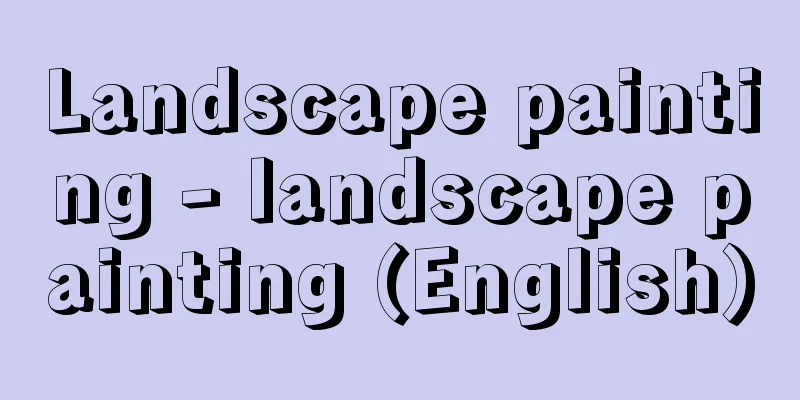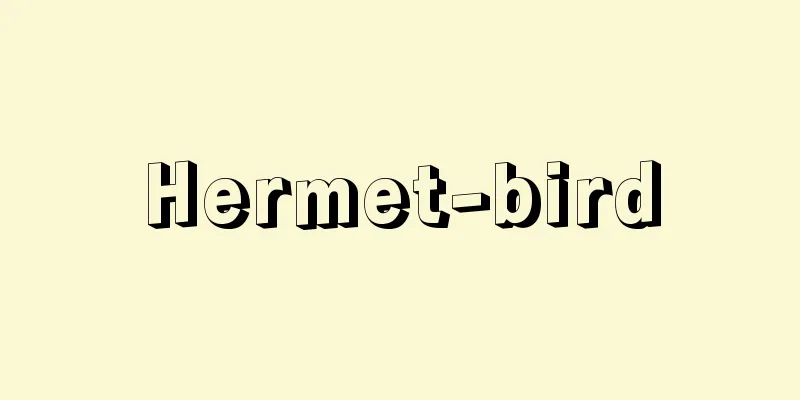Landscape painting - landscape painting (English)

|
Paintings depicting outdoor landscapes such as natural scenery, cities, and architecture. Along with the human body, they are the most important subject of pictorial expression, and convey the natural and spatial consciousness of each era and society. However, in ancient Egypt, Mesopotamia, Greece, and other places, even though natural elements are placed in the background of various themes, especially genre scenes and narrative scenes, they are still limited to symbolic and symbolic expressions. The consciousness of natural space, including the landscape of cities and architecture, in other words, the attempt to grasp the space seen from a certain viewpoint in a unified two-dimensional plane, appears in murals and mosaics depicting pastoral scenes in the Hellenistic period, and is inherited by Roman painting. There, the unity of the perspective view of the early modern period is not fully possessed, but the landscape is appreciated for its pastoral and fantastical nature, and works that are almost like pure landscape paintings are created. In the Middle Ages, the background space was again conceptualized and symbolized. However, in the late Middle Ages, the consciousness of a unified space appeared in both religious and secular scenes. Ambrogio Lorenzetti's "The Good Government" (floor painting in the Palazzo Pubblico, Siena), which belongs to the first half of the 14th century, depicts hills, fields, and cities in an open view, and depictions of natural space also appear in manuscript decorations and tapestries. During the Renaissance, with the discovery and establishment of linear perspective in Italy and the development of empirical perspective techniques in Flanders, scenes, whether religious, mythological or portrait, came to be set in realistic natural or urban spaces. During this exploration of nature, landscape paintings, which were almost independent, were born, as shown by the small drawings and watercolors of Altdorfer, Leonardo da Vinci and Dürer. From the late 16th century to the 17th century, landscape painting gradually became independent, and many works were produced that included allegorical, religious, and mythological themes, but also placed emphasis on the landscape. A wide variety of landscape paintings were produced, including topographical landscapes, "world landscapes" that combined the scenery of various lands, so-called "heroic" idealistic landscapes that incorporate themes from mythology, ruins paintings that favor ancient ruins as their subject matter, cityscapes, and seascapes. Many excellent landscape paintings were left behind by 17th century Dutch artists such as Rembrandt, Ruisdael, and Hobbema, French artists such as Claude Lorrain and Poussin, and Spanish artist Velázquez. The interest in light seen in 17th century landscape paintings was explored more vividly by painters such as Gainsborough and Constable in 18th century England, Canaletto in Italy, and Fragonard in France, and continued into the heyday of landscape painting in the 19th century and after the Romantic period. The approach to nature of early 19th century realists such as Constable, the French Barbizon School, and Courbet reached a peak with Impressionism. Modern landscape painting was transformed by a more materialistic view of nature, replacing the traditional idealistic and romanticist view of nature with an emotional response to the ever-changing light and atmosphere. Until the 18th century, landscape painting was considered a lower genre in the French Academy compared to religious and historical paintings, but in the 19th century, it became one of the most important genres alongside still life and figure painting. It has developed in a variety of ways due to the styles of each school and individual artist since the Impressionists, and has asserted its status as a genre in the remarkable transformation of artistic expression in the 20th century. In the Orient, it is generally known as landscape painting and constitutes a genre in its own right. [Kimio Nakayama] "K. Clark, translated by Eiya Sasaki, "Selected Works of Fine Arts 4: Landscape Painting" (1976, Iwasaki Bijutsusha)" [Reference] |Oil painting, around 1639, Paris Museum Lorrain: "Landscape with the Port of Santa Marinella..." 1640 Oil on canvas (Collection of the Art Institute of Chicago ) Poussin: Landscape with St. John on the Island of Patmos... Probably mid-1850s, oil painting , Metropolitan Museum of Art Courbet's "Landscape at Ornans" Source: Shogakukan Encyclopedia Nipponica About Encyclopedia Nipponica Information | Legend |
|
自然の風景、都市、建築など、戸外の景観を描いた絵画。絵画表現のなかで、人体像とともにもっとも主要な対象となり、それぞれの時代・社会の自然観、空間の意識を伝えてくれる。しかし、古代エジプト、メソポタミア、ギリシアなどでは、さまざまな主題、とくに風俗的情景、物語的情景の背景に自然の諸要素が配置されていることがあっても、それらはまだ記号的・象徴的な表現にとどまっている。都市や建築の景観を含めた自然空間への意識、換言するなら、ある視点から見た空間を二次元上の平面に統一的に把握しようとする試みは、ヘレニズム期の田園詩的情景を示す壁画やモザイク類に現れ、ローマ絵画に受け継がれる。そこには、近世の遠近法的な視野の統一性は十分に備わっていないが、風景がその牧歌性、幻想性によって鑑賞され、ほとんど純粋な風景画に近い作品が成立する。 中世には、背景空間はふたたび観念化され、象徴化される。けれども中世後期、宗教画の情景設定にも、世俗的な主題の情景にも、統一的空間の意識が現れる。14世紀前半に属するアンブロジオ・ロレンツェッティの『善政』(シエナ、パラッツォ・プブリコの壁画)は、広やかな眺望の中に丘や野、都市を描き、また手写本装飾画やタペストリーにも、自然空間の描写が現れる。 ルネサンス期、イタリアにおける線遠近法の発見と確立、フランドルにおける経験的な遠近表現の技法の発達によって、宗教画、神話画、肖像画を問わず、情景は現実的な自然空間や都市空間の中に設定されることとなる。そうした自然探究の間に、アルトドルファー、レオナルド・ダ・ビンチ、デューラーたちの小品の素描、水彩画が示すように、ほとんど独立した風景画が生まれる。 16世紀後半から17世紀にかけて、風景画はしだいに独立し、寓意(ぐうい)、宗教、神話などの主題を含みながらも風景に重点を置く作品も多く制作される。地誌的風景、逆にさまざまな土地の風物を合成した「世界風景」、神話などの題材を含んで展開するいわゆる「英雄的」理想主義的風景、古代の遺跡などを好んで題材とする遺跡画、都市風景、海景など、多様な風景画が成立する。17世紀オランダのレンブラント、ロイスダール、ホッベマ、フランスのクロード・ロラン、プサン、スペインのベラスケスなどが多くの優れた風景画を残している。 17世紀の風景画にみられる光への関心は、18世紀イギリスのゲーンズバラ、コンスタブル、イタリアのカナレット、フランスのフラゴナールたちによって、いっそう生き生きとした探求となり、19世紀のロマン派以降の風景画全盛期へと受け継がれる。 19世紀初頭のコンスタブル、フランスのバルビゾン派、クールベたちリアリストの自然への接近は、印象主義によって一つの頂点を迎える。従来の理想主義的、ロマン主義的な自然観にかわって、より即物的な視覚、時々刻々に変化する光や大気への情緒の成立によって、近代風景画の変革がなされたのである。 18世紀まで、フランスのアカデミーでは、宗教画、歴史画に比べて、風景画は低いジャンルとみなされてきたが、19世紀には、風景画は静物画や人物画と並ぶもっとも主要なジャンルとなり、印象派以降の各流派、各個性のそれぞれの作風によって多様な展開を遂げ、20世紀における造形の目覚ましい変革のなかでも、一つのジャンルであることを主張している。 なお、東洋では一般に山水画とよばれ、一ジャンルを形成している。 [中山公男] 『K・クラーク著、佐々木英也訳『美術名著選書4 風景画論』(1976・岩崎美術社)』 [参照項目] |1639年ころ 油彩ParisMusées"> ロラン『サンタ・マリネッラ港のある風景… 1640年 油彩シカゴ美術研究所所蔵"> プサン『パトモス島の聖ヨハネのいる風景… おそらく1850年代中期 油彩メトロポリタン美術館所蔵"> クールベ『オルナンの風景』 出典 小学館 日本大百科全書(ニッポニカ)日本大百科全書(ニッポニカ)について 情報 | 凡例 |
<<: Landscape photography - landscape photography
Recommend
pamphleteer
...People of each position tried to defeat their ...
Catchphrase
〘noun〙 (catchword) ① a slogan, a catchphrase, or a...
Epaphos - Epaphos
…Then Zeus ordered Hermes to kill Argos, and Hera...
Keratan sulfate
…Many of them have acidic groups such as uronic a...
Il Pecorone - Il Pecorone
…The success of the Decameron gave rise to many s...
Suchoň, E. (English spelling) SuchonE
…A Central European republic that existed from 19...
Lippi, Fra Filippo
Born: 1406. Florence [Died] October 8/10, 1469. Sp...
Law of diminishing returns
A fundamental proposition in economics regarding ...
pivot
〘noun〙 (pivot) 1. A pivot. The support end of a pi...
Transzendentalism (English spelling) [Germany]
A term referring to the characteristics of Kant an...
Weininger, Otto
[Born] 1880 [Died] 1903 Austrian philosopher. He p...
Scale - Memori
〘noun〙 The act of putting marks on measuring instr...
Mythologiques (English spelling)
...This method brought about an innovative unders...
Peace Corps
The organization was established by the U.S. gove...
Adirondack Mountains - Adirondack Sanctuary
Adirondack Mountains : A mountain range in the nor...









